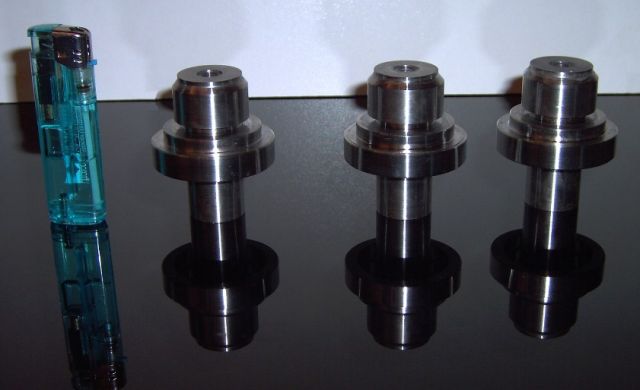Sonic Power Ultrasonic titanium booster solid mount 40 kHz, without O-rings and therefore extreme rigid
Email : info@sonic-power.com
Ultrasonic Boosters are available with ratios of
- 1:0:5, reduce the amplitude / vibrations.
- 1:1.0 keep the amplitude without change
- 1:1.5 increase the amplitude / vibrations.
- 1:2.0 increase the amplitude / vibrations.
- 1:2.5.increase the amplitude / vibrations.
- 1:3.0 increase the amplitude / vibrations.
- Special boosters are made per request.
The Ultrasonic Booster is like the gear in a car, where as the lowest is first gear and so forward. This also means that the higher ultrasonic booster you put on the more power is needed behind to start it, so even if the ultrasonic horn can take more gain (higher ratio), if you ultrasonic generator is not powerfully enough you will not be able to start it up and the Ultrasonic generator will go into overload.
The Ultrasonic booster is a one half-wavelength long resonant section made of aluminum or titanium. It is mounted between the Ultrasonic converter and the Ultrasonic horn, and modifies the amplitude of vibration applied to the Ultrasonic horn.
The success of an ultrasonic plastics assembly application is dependent on the required force, time, and velocity factor to obtain the correct energy level. The ultrasonic velocity factor is obtained by using the correct ultrasonic horn and ultrasonic booster combination to provide the optimum amplitude for the type of plastic, size of part, and type of assembly to be per-formed. Since it may be technically impractical to design the correct amplitude into the ultrasonic horn because of its shape, ultrasonic boosters are used to either increase or decrease the amplitude at the ultrasonic horn face to transmit the required energy to the joint interface.
To provide amplitude change, the ultrasonic booster will have different diameters and mass on either side of its centre or nodal point.
An amplitude increasing booster has a smaller mass at the end attached to the ultrasonic horn, while an amplitude decreasing ultrasonic booster has a greater mass at the end attached to the ultrasonic horn.
Choosing the Correct ultrasonic Booster: When selecting a ultrasonic booster to be used for an application, it is recommended to use the lowest gain ratio possible that will provide acceptable application results for correct amplitudes values. This will help to operate the ultrasonic horns at lower fatigue levels, which increases tooling reliability.

